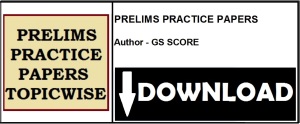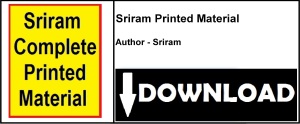Showing posts with label GS Paper 1. Show all posts
Showing posts with label GS Paper 1. Show all posts
Tuesday, December 13, 2016
Monday, December 12, 2016
Friday, December 09, 2016
UPSC MAINS 2016 GS Paper 1 { Detailed hints and structures of answers }
VisionIAS
09:20
Have you appeared in Civil Services Mains 2016 conducted by UPSC? Are you
planning to appear next year? Here is the detailed hints and structures of answers of all
the questions of General Studies Paper 1. Read on!
planning to appear next year? Here is the detailed hints and structures of answers of all
the questions of General Studies Paper 1. Read on!
1. Early Buddhist Stupaart, while depicting folk motifs and narratives, successfully expounds Buddhist
ideals. Elucidate.
ideals. Elucidate.
Answer:
Stupa: A symbolisation of Buddha, with base being his crossed legs to top being his head
Creates an axismundi for the devotees connecting day to day life to divine
Creates a place for socialisation and meditation, important in Buddhism
Art displayed on stupas ensure the adherence to ideals of religion, creating a space, which becomes a microrepresentation of Buddha himself.
Stupa: A symbolisation of Buddha, with base being his crossed legs to top being his head
Creates an axismundi for the devotees connecting day to day life to divine
Creates a place for socialisation and meditation, important in Buddhism
Art displayed on stupas ensure the adherence to ideals of religion, creating a space, which becomes a microrepresentation of Buddha himself.
2. Krishnadeva Raya, the king of Vijayanagar, was not only an accomplished
scholar himself but was a also a great patron of learning and literature. Discuss.
scholar himself but was a also a great patron of learning and literature. Discuss.
Answer:
Vijayanagar empire was a cultural centre of India.
Krishnadeva Raya’s patronage to Telugu literature, Astadiggajalu (8 poets)
Amuktamalyada, his own work describes separation
Tamil poet Haridas was also patronised
In Sanskrit, Vyasaritha was also patronised in writing legendary books
Vijayanagar empire was a cultural centre of India.
Krishnadeva Raya’s patronage to Telugu literature, Astadiggajalu (8 poets)
Amuktamalyada, his own work describes separation
Tamil poet Haridas was also patronised
In Sanskrit, Vyasaritha was also patronised in writing legendary books
3. Explain how the upraising of 1857 constitutes an important watershed in the
evolution of British policies towards colonial India.
evolution of British policies towards colonial India.
Answer:
Politically, India came under the crown. End of East India Company.
Socially, less intervention in Indian traditions
Economically, Britishers dug deeper and started treating India as a long term settlement instead of a place for
plunder
End of the arbitrary annexation and respect to the local kings
Beginning of the idea of representation to locals in governance
Politically, India came under the crown. End of East India Company.
Socially, less intervention in Indian traditions
Economically, Britishers dug deeper and started treating India as a long term settlement instead of a place for
plunder
End of the arbitrary annexation and respect to the local kings
Beginning of the idea of representation to locals in governance
4. Discuss the role of women in the freedom struggle especially during the
Gandhian phase.
Gandhian phase.
Answer:
Women being active participants in the struggle starting from first war. Laxmibai, Hazrat Mahal etc.
Gandhian phase was a movement of social awakening for a free, liberated and moral society; in which women
were pivotal
Women leaders were there, and Gandhi’s idea of swadeshi, boycott of liquor merged the boundaries of
national and social
Some important leaders, Sarojini Naidu, Vijaylaxmi Pandit, Usha Mehta, Annie Besant etc.
Women being active participants in the struggle starting from first war. Laxmibai, Hazrat Mahal etc.
Gandhian phase was a movement of social awakening for a free, liberated and moral society; in which women
were pivotal
Women leaders were there, and Gandhi’s idea of swadeshi, boycott of liquor merged the boundaries of
national and social
Some important leaders, Sarojini Naidu, Vijaylaxmi Pandit, Usha Mehta, Annie Besant etc.
5. Highlight the differences in the approach of Subhash Chandra Bose and
Mahatma Gandhi in the struggle for freedom.
Mahatma Gandhi in the struggle for freedom.
Answer:
Bose was a modern left oriented leader, while Gandhi had a moralistic approach towards nation building.
Biggest diversion was about India’s stand with respect to the world politics. Gandhi has a moralistic stand of
opposing the Nazi regime. Bose, on the other hand was more pragmatic and wanted to work with Germany
and Japan to destabilise Britishers.
Bose was not averse to the idea of violence for independence unlike Gandhi.
Bose was a modern left oriented leader, while Gandhi had a moralistic approach towards nation building.
Biggest diversion was about India’s stand with respect to the world politics. Gandhi has a moralistic stand of
opposing the Nazi regime. Bose, on the other hand was more pragmatic and wanted to work with Germany
and Japan to destabilise Britishers.
Bose was not averse to the idea of violence for independence unlike Gandhi.
6. Has the formation of linguistic states strengthened the cause of Indian unity?
Answer:
Linguistic reorganisation of India was the most logical and obvious idea for creation of culturally similar
administrative units.
Has been uniting at the regional level, but has created pockets of regional linguistic muscle.
Created interregional conflicts. Tamil linguistic issue, Marathi nationalism etc.
In conclusion, it has created multiple nodal points of cultural energy which is essential for a country as diverse
as India but has hindered the process of national unification.
Answer:
Linguistic reorganisation of India was the most logical and obvious idea for creation of culturally similar
administrative units.
Has been uniting at the regional level, but has created pockets of regional linguistic muscle.
Created interregional conflicts. Tamil linguistic issue, Marathi nationalism etc.
In conclusion, it has created multiple nodal points of cultural energy which is essential for a country as diverse
as India but has hindered the process of national unification.
7. The anticolonial struggles in West Africa were led by the new elite of Western
educated Africans. Examine.
educated Africans. Examine.
Answer:
The lack of a unique African identity, no common craving for independence
Ideas of liberty, independence etc were the creations of western philosophers and literature
No leaders of a stature of panAfrican influence
The lack of a unique African identity, no common craving for independence
Ideas of liberty, independence etc were the creations of western philosophers and literature
No leaders of a stature of panAfrican influence
8. To what extent globalisation has influenced the core of cultural diversity in
India? Explain.
India? Explain.
Answer:
Globalisation as a diversity infuser: Western food, clothes, jobs, lifestyle
Globalisation as a diversity buster: Similar dresses (pant shirt), food (Chinese), Jobs (BPO) across India.
Similar movies, music etc.
In conclusion, it has altered the domain of the cultural diversity in India in a way that it has to try hard to retain
some of the original character.
Globalisation as a diversity infuser: Western food, clothes, jobs, lifestyle
Globalisation as a diversity buster: Similar dresses (pant shirt), food (Chinese), Jobs (BPO) across India.
Similar movies, music etc.
In conclusion, it has altered the domain of the cultural diversity in India in a way that it has to try hard to retain
some of the original character.
9. “An essential condition to eradicate poverty is to liberate the poor from the
process of deprivation.” Substantiate this statement with suitable examples.
process of deprivation.” Substantiate this statement with suitable examples.
Answer:
Poverty is institutionalised by the established processes, which deprive poor
It is not an individual trait, which can be cured person to person.
Institutional cure is to provide poor the direct access to resources, not through a process of rationing and
various channels
Example, MNREGA, Food Security Act
Poverty is institutionalised by the established processes, which deprive poor
It is not an individual trait, which can be cured person to person.
Institutional cure is to provide poor the direct access to resources, not through a process of rationing and
various channels
Example, MNREGA, Food Security Act
10. Why are the tribals in India referred to as ‘the Scheduled Tribes’? Indicate the
major provisions enshrined in the Constitution of India for their upliftment.
major provisions enshrined in the Constitution of India for their upliftment.
Answer:
Scheduled tribes are the “adivasis” (original inhabitants) which have been recognised by the constitution of
India. Article 342 provides the power to President and Governor to make the lists of ST.
The idea of calling them scheduled is to provide them constitutional legitimacy.
Steps taken by the government, affirmative action (reservation), preventive (SC/ST Act etc), National
Commission for ST etc.
Scheduled tribes are the “adivasis” (original inhabitants) which have been recognised by the constitution of
India. Article 342 provides the power to President and Governor to make the lists of ST.
The idea of calling them scheduled is to provide them constitutional legitimacy.
Steps taken by the government, affirmative action (reservation), preventive (SC/ST Act etc), National
Commission for ST etc.
11. With a brief background of quality of urban life in India, introduce the
objectives and strategy of the ‘Smart City Programme.”
objectives and strategy of the ‘Smart City Programme.”
Answer:
Urban poverty, slums, poor sanitation, transport, healthcare, pollution etc. Poor quality of urban living.
Smart City is with core infrastructure, sustainable environment, digital and smart solutions as far as the
problem resolution id concerned.
Urban poverty, slums, poor sanitation, transport, healthcare, pollution etc. Poor quality of urban living.
Smart City is with core infrastructure, sustainable environment, digital and smart solutions as far as the
problem resolution id concerned.
12. What is the basis of regionalism? Is it that unequal distribution of benefits of
development on regional basis eventually promotes regionalism? Substantiate
your answer.
development on regional basis eventually promotes regionalism? Substantiate
your answer.
Answer:
Basis of regionalism: Local identities, similar life choices, language etc.
Unequal distribution of benefits: strengthens regional identities, creates feeling of chauvinism among better off
(eg. Maharashtra) and injustice among the deprived ones (eg. Telangana)
Also encourages the demand of new regions on the basis of differential development maps of areas. (eg. Harit
Pradesh)
Basis of regionalism: Local identities, similar life choices, language etc.
Unequal distribution of benefits: strengthens regional identities, creates feeling of chauvinism among better off
(eg. Maharashtra) and injustice among the deprived ones (eg. Telangana)
Also encourages the demand of new regions on the basis of differential development maps of areas. (eg. Harit
Pradesh)
13. Discuss the concept of air mass and explain its role in macroclimatic
changes.
changes.
Answer:
Air mass: huge parcels of air with similar characteristics. Can be safely taken to be having constant weather
indicators like temperature, humidity, lapse rate etc. anywhere within an airmass
Air mass is one of the most important factors determining the long term climatic orientation of a place
Due to shifting of air masses the climatic change become real and widespread. It might be a natural
phenomenon as well.
Air mass: huge parcels of air with similar characteristics. Can be safely taken to be having constant weather
indicators like temperature, humidity, lapse rate etc. anywhere within an airmass
Air mass is one of the most important factors determining the long term climatic orientation of a place
Due to shifting of air masses the climatic change become real and widespread. It might be a natural
phenomenon as well.
14. “The Himalayas are highly prone to landslides.”Discuss the causes and
suggest suitable measures of mitigation.
suggest suitable measures of mitigation.
Answer:
Reasons for landslide probability in Himalayas: Location at the convergence zone of two lithospheric plates
creating multiple fault zones.
Anthropogenic activities, like construction, roads, deforestation etc.
Mitigation: Less construction, afforestation, ban on grazing, quarrying, no industrial activity.
Reasons for landslide probability in Himalayas: Location at the convergence zone of two lithospheric plates
creating multiple fault zones.
Anthropogenic activities, like construction, roads, deforestation etc.
Mitigation: Less construction, afforestation, ban on grazing, quarrying, no industrial activity.
15. The effective management of land and water resources will drastically reduce
the human miseries. Explain.
the human miseries. Explain.
Answer:
Unmanaged land means not optimally being used for productive purposes, leads to lack of resources,
employment etc.
Water resources’ mismanagement creates a severe lack of drinking water and for every other purpose as well.
The sum total of land and water are not deficient. They are being mismanaged and wasted.
The impact is disproportionately high on poor, women etc.
Unmanaged land means not optimally being used for productive purposes, leads to lack of resources,
employment etc.
Water resources’ mismanagement creates a severe lack of drinking water and for every other purpose as well.
The sum total of land and water are not deficient. They are being mismanaged and wasted.
The impact is disproportionately high on poor, women etc.
16. South China Sea has assumed great geopolitical significance in the present
context. Comment.
context. Comment.
Answer:
Usual geopolitical importance of South China Sea lies in its linking of Indian ocean and the Pacific and having
access to important trade routes
In present sense, it has become a barometer of the Chinese expansionist ideology
It will indicate how China and the world bodies strike a balance when it comes to issues like territorial
sovereignty.
Usual geopolitical importance of South China Sea lies in its linking of Indian ocean and the Pacific and having
access to important trade routes
In present sense, it has become a barometer of the Chinese expansionist ideology
It will indicate how China and the world bodies strike a balance when it comes to issues like territorial
sovereignty.
17. Major cities of India are becoming vulnerable to flood conditions. Discuss.
Answer:
Mumbai flood 2005, Chennai flood 2015
Poor water drainage facilities. If water enters, no way of leaving
Excess construction, no open land left to absorb excess rainwater.
No green cover to mitigate the flood like conditions.
Mumbai flood 2005, Chennai flood 2015
Poor water drainage facilities. If water enters, no way of leaving
Excess construction, no open land left to absorb excess rainwater.
No green cover to mitigate the flood like conditions.
18. Present an account of the Indus Water Treaty and examine its ecological,
economic and political implications in the context of changing bilateral relations.
economic and political implications in the context of changing bilateral relations.
Answer:
Indus Water Treaty signed in 1960 between India and Pakistan, and was brokered by World Bank, decides the
water distribution of river Indus and its tributaries between the two countries.
Ravi, Beas and Sutlej for India’s exclusive use. Jhelum and Chenab for Pakistan’s.
Indus river system is very important for both the countries as farmers from both sides depend on it.
It has become a political tool of negotiation and centre of public sentiment due to escalated tensions between
the two countries.
Indus Water Treaty signed in 1960 between India and Pakistan, and was brokered by World Bank, decides the
water distribution of river Indus and its tributaries between the two countries.
Ravi, Beas and Sutlej for India’s exclusive use. Jhelum and Chenab for Pakistan’s.
Indus river system is very important for both the countries as farmers from both sides depend on it.
It has become a political tool of negotiation and centre of public sentiment due to escalated tensions between
the two countries.
19. Enumerate the problems and prospects of inland water transport in India.
Answer:
Detailed network of Inland waterways in India, almost 14500 Km, but not very popular
There is a seasonal fall in water level in rivers especially in the Rainfed Rivers of the peninsula which become
nearly dry during summer.
Reduced flow due to diversion of water for irrigation, for instance, in the Ganga which makes it difficult even for
steamers to ply.
There is reduced navigability due to siltation, as in the BhagirathiHooghly and in the Buckingham Canal.
There are problems in smooth navigation because of waterfalls and cataracts, as in Narmada and Tapti.
Salinity, especially in the coastal stretches, affects navigation.
Detailed network of Inland waterways in India, almost 14500 Km, but not very popular
There is a seasonal fall in water level in rivers especially in the Rainfed Rivers of the peninsula which become
nearly dry during summer.
Reduced flow due to diversion of water for irrigation, for instance, in the Ganga which makes it difficult even for
steamers to ply.
There is reduced navigability due to siltation, as in the BhagirathiHooghly and in the Buckingham Canal.
There are problems in smooth navigation because of waterfalls and cataracts, as in Narmada and Tapti.
Salinity, especially in the coastal stretches, affects navigation.
20. In what way microwatershed development projects help in water
conservation in droughtprone and semiarid regions of India?
conservation in droughtprone and semiarid regions of India?
Answer:
Micro watershed is the watershed having area of 5001000 hectare. It’s the smallest unit in the hierarchy of
watershed.
It caters to the local intricacies, focussing more on optimising local water resources.
It is generally more citizen driven which is helpful in areas which have limited resources like arid and semiarid
regions.
Micro watershed is the watershed having area of 5001000 hectare. It’s the smallest unit in the hierarchy of
watershed.
It caters to the local intricacies, focussing more on optimising local water resources.
It is generally more citizen driven which is helpful in areas which have limited resources like arid and semiarid
regions.
Monday, November 21, 2016
Saturday, November 19, 2016
Revise 10 questions everyday from Prelims Past Papers (2015 to 1979)
VisionIAS
20:58
23rd November, 2016 (Prelims)
22nd November, 2016 (Prelims)
21st November, 2016 (Prelims)
20th November, 2016 (Prelims)
18th November, 2016 (Prelims)
17th November, 2016 (Prelims)








